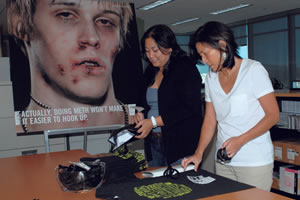Battling The Meth Epidemic
Interviewed by Rasa Fournier
Wednesday - May 18, 2011
E-mail this story | Print this page | Comments (0) | Archive
 Del.icio.us Share
Del.icio.us Share

Cindy Adams
Executive director of the Hawaii Meth Project
How did you get involved with the Hawaii Meth Project?
I got involved because my family has been affected by crystal meth. We experienced the pain, fear, sadness and frustration that families experience when you learn someone close to you is addicted to this drug. We felt the financial burden it places on families and know the cost it imposes on Hawaii’s social services. I wanted to make a difference for other families - prevent them from going through that. At about the time I gained awareness of meth, the Meth Project was exploring the possibility of introducing the program in Hawaii.
Tom Siebel started the Montana Meth Project in 2005. He developed an approach based on a consumer marketing model and refined it through hundreds of hours of research with addiction specialists and focus groups, and direct experience in Montana. Meth is at epidemic levels in many states in the U.S.
There are now Meth Projects in eight states. I’ve been with the Hawaii Meth Project since the beginning - just over two years.
Did the problem start in Hawaii?
I’ve heard different stories - whether or not crystal meth was first introduced here, it certainly took hold in a big way.
What services does the Hawaii Meth Project offer?
We focus on prevention and spend most of our time on direct services to the community through outreach and education. Jennifer Phakoom, our program manager, spends 3 to 5 days a week in schools across the state talking to intermediate and high school students in health classes, school assemblies, and peer education classes, educating them about the risks and dangers associated with crystal meth. I meet with the broader community to raise awareness.
Can you talk about signs and symptoms of a user?
The physical changes really vary and depend on how frequently people use and how long they’ve been using. When someone uses frequently, several times a week or every day, they can lose weight because they’re not eating or sleeping. The drug becomes their focus; it takes over their life. They can have sores and scabs from picking at acne or from scratching when they sweat or when they hallucinate about bugs under their skin. Hygiene is less important as getting high becomes more important. Another change can be the appearance of meth mouth. They’re not brushing their teeth and they drink a lot of soda because it hurts to eat with so many cavities. Their hair, eyebrows and eyelashes can thin or start to fall out. Some addicts will pull their hair out, one strand at a time.

|
Some people are occasional users, and you might not see the dramatic physical changes. You might notice the behavioral changes - changes to attitude, mood, energy level, bouts of depression. It might be difficult to tell if someone is a functional or occasional users. Someone with ADD might smoke ice to help them focus. It’s still illegal. Functional users could be anyone - a professional with a family, for example.
Is it possible to use occasionally and not have it be detrimental?
The kids I’ve spoken with are either in treatment or in a correctional facility. I’d say it’s been detrimental to their lives.
How big is the problem in the state?
One of the statistics that speaks to the enormity of the public health problem is that in 2007 the Substance Abuse and Mental Health Services Administration released national statistics that showed Hawaii ranked No. 5 in the nation for meth use, ages 12 and older. Additionally, the largest percentage of drug-treatment admissions in our state are driven by methamphetamine - 48 percent, surpassing alcohol. Forty-three percent of federal convictions in Hawaii involve methamphetamine. Meth has a disproportionately higher impact socio-economically than other drugs -increased incarceration and foster care, less job productivity, and increased healthcare and treatment costs.
What’s the most challenging part of your job?
The hardest part is listening to kids whose lives have already been affected by meth; how they regret taking that first hit - they didn’t think they would become addicted - and the guilt they feel because they hurt their families. Often, they’ve lost their friends; their families don’t trust them anymore. For many, staying sober will be a lifelong struggle.
Is there hope?
There is hope in prevention through education. Addicts can recover, and it is often a painful struggle for the user and family, and at an enormous cost to the state and insurance companies. “Not Even Once” really says it all.
Any final thoughts?
Hawaii has a long history with meth. It has affected multiple generations of families - grandparents, parents, children, grandchildren and great-grandchildren. We must change the social norm to break this cycle. Breaking the cycle requires prevention, treatment, law enforcement and support from the whole community.
E-mail this story | Print this page | Comments (0) | Archive
Most Recent Comment(s):













